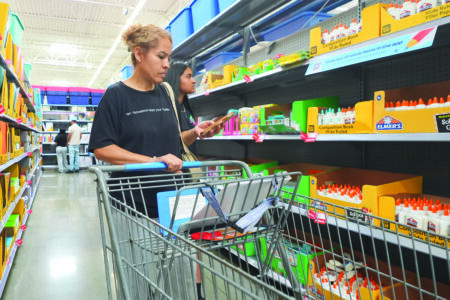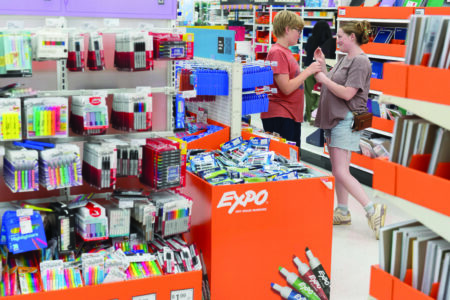Technology
New Smart Glasses from Meta, Oakley May Launch This Week
Meta and Oakley are preparing to unveil a new line of smart glasses, with a formal announcement expected on June 20. A new Instagram account, @oakleymeta, posted a brief video teaser that ends with both the Meta and Oakley logos, signaling a collaboration. The post was reshared by Meta CEO Mark Zuckerberg, Oakley, and the […]

Meta and Oakley are preparing to unveil a new line of smart glasses, with a formal announcement expected on June 20. A new Instagram account, @oakleymeta, posted a brief video teaser that ends with both the Meta and Oakley logos, signaling a collaboration. The post was reshared by Meta CEO Mark Zuckerberg, Oakley, and the official Instagram handle, giving further weight to the upcoming launch.
The teaser has also made its way to Meta’s digital storefront, which now displays a banner that reads, “The next evolution arrives June 20,” along with a prompt to subscribe for updates. This move hints at an imminent product release.
Reports suggest that the new glasses may be inspired by Oakley’s Sphaera frame. Unlike the Ray-Ban Meta glasses, which include a camera on the side, the Oakley model may place its camera at the center of the frame. This design choice points to a shift toward serving athletes, particularly cyclists, with action-oriented features—potentially putting the product in competition with devices like GoPro.
Oakley and Ray-Ban operate under the same corporate umbrella—EssilorLuxottica—making the partnership with Meta a logical extension. What distinguishes this collaboration is the apparent targeting of the sports-tech segment and the change in form factor to match high-movement use cases. The official reveal is scheduled for June 20.
Technology
Irish medtech Sports Impact Technologies raises €650K for better concussion detection
Dublin-based startup Sports Impact Technologies has raised €650,000 in Pre-Seed funding to roll out its behind-the-ear wearable device that detects potentially dangerous head impacts in real time, aiming to address the widespread issue of undetected concussions in sport. The round was led by private investors and supported by Enterprise Ireland through its High-Potential Start-Up (HPSU) […]
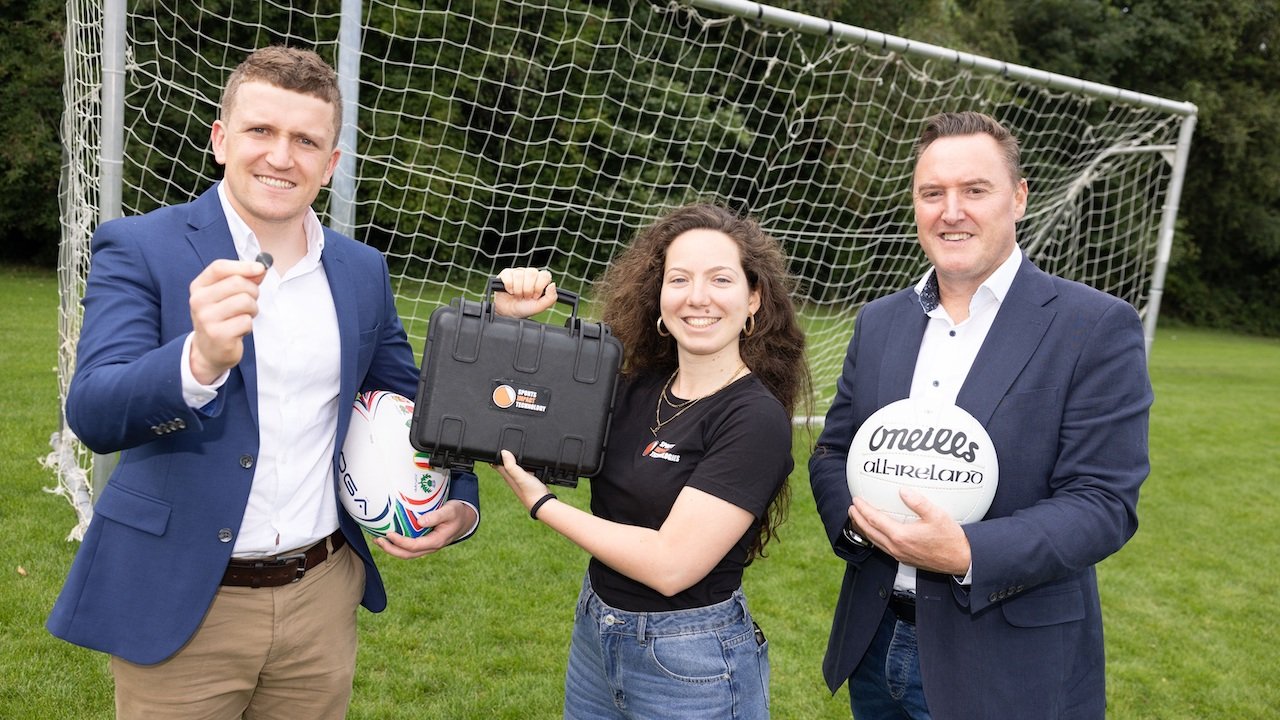
Dublin-based startup Sports Impact Technologies has raised €650,000 in Pre-Seed funding to roll out its behind-the-ear wearable device that detects potentially dangerous head impacts in real time, aiming to address the widespread issue of undetected concussions in sport.
The round was led by private investors and supported by Enterprise Ireland through its High-Potential Start-Up (HPSU) programme. The funding will support the final stages of product development and enable the launch of beta testing with athletes this September, according to the company.
Founded in 2022 by Eóin Tuohy, Sports Impact Technologies is developing a lightweight sensor that sits discreetly behind the ear. The device monitors head accelerations during gameplay and transmits data and alerts via an app to coaches, medics, or officials. The goal is to allow informed, immediate decisions about whether a player should be removed from play to be assessed for a concussion.
While concussion awareness has grown across professional and amateur sports in recent years, the challenge of detecting concussions in real time — particularly at lower levels of play — remains significant. Many athletes continue to play through symptoms, often unknowingly, risking long-term neurological harm.
“It is estimated that between 5 and 10 percent of players experience a concussion in any given sports season, with 5 in 10 concussions going unreported or undetected leading to players experiencing long-term health implications,” said Eóin Tuohy, CEO and founder of Sports Impact Technologies.
“Using our smart sensor technology to monitor head impacts in real-time, our goal is to make unrecognised concussions a thing of the past protecting athletes, optimising their performance, and enabling participation.”
The beta phase will include pilots across a wide range of sports – including rugby, American football, soccer, hockey, and GAA – and is scheduled to begin in September 2025. The startup aims for a full commercial launch in early 2026.
“We’re thrilled to have closed this funding round with the backing of both private investors and Enterprise Ireland,” Tuohy added. “The investment will support the final stages of product development and help us bring our beta wearable to market.”
Sports Impact Technologies previously participated in Enterprise Ireland’s New Frontiers Programme at TU Dublin, secured €100,000 in Pre-Seed Start Fund (PSSF) financing, and is a client of the European Space Agency Business Incubation Centre (ESA BIC). In 2024, the company also won the ‘Best New Start’ award at the Connacht and Leinster regional final of the InterTradeIreland Seedcorn Investor Readiness Competition.
Enterprise Ireland, which has supported the venture from its early stages, sees the startup as part of a growing wave of Irish companies addressing global markets with specialised hardware and deep-tech solutions.
“Enterprise Ireland is proud to support Sports Impact Technologies through our High-Potential Start-Up funding,” said Keith Brock, Senior Client Advisor, Enterprise Ireland.
“This investment reflects our commitment to backing innovative Irish companies that are solving real-world challenges with global relevance. The team’s wearable sensor technology is a game-changer for athlete safety, and we’re excited to support their journey as they bring this product to market.”
Technology
Peloton Interactive to Upgrade Products with New Hardware and AI Technology.
Peloton Interactive, a global fitness company, is upgrading its products with new hardware and AI. The company operates an interactive fitness platform with a community of over 6 million members, offering connected fitness products and subscription services. Peloton’s Connected Fitness Products include bikes, treadmills, and rowing machines, while subscriptions provide access to live and on-demand […]

Peloton Interactive, a global fitness company, is upgrading its products with new hardware and AI. The company operates an interactive fitness platform with a community of over 6 million members, offering connected fitness products and subscription services. Peloton’s Connected Fitness Products include bikes, treadmills, and rowing machines, while subscriptions provide access to live and on-demand fitness classes. The upgrades aim to enhance the user experience and offer more personalized fitness solutions.
Title: Peloton’s AI-Driven Reinvention: A Strategic Bet on the Future of Fitness
Peloton Interactive, a leading global fitness company, is embarking on a significant upgrade to its product offerings with a focus on artificial intelligence (AI) and new hardware. The company operates an interactive fitness platform with over 6 million members, providing connected fitness products and subscription services. Peloton’s connected fitness products include bikes, treadmills, and rowing machines, while subscriptions offer access to live and on-demand fitness classes. The upgrades aim to enhance the user experience and provide more personalized fitness solutions.
Peloton’s latest move involves the introduction of “Peloton Intelligence,” an AI-driven system that leverages biometric data and third-party integrations to deliver personalized workouts. The company has also acquired Precor for $420 million, aiming to unify its home and commercial fitness ecosystems. These strategic initiatives are part of Peloton’s broader effort to differentiate itself in a crowded market dominated by ecosystem leaders like Apple and Amazon.
The Q2 2025 results for Peloton highlight a significant turnaround in its financial performance. The company reported a 171% increase in adjusted EBITDA to $140 million, driven by 20% cost reductions and a shift to high-margin subscription revenue, now constituting 62% of total revenue. Despite this growth, Peloton faces several risks, including potential R&D cuts, pricing pressures, and challenges in global expansion.
Investors must assess Peloton’s ability to execute its AI strategy, successfully integrate Precor’s commercial equipment, and differentiate itself in the AI fitness market. Peloton’s focus on fitness-specific personalization could carve out a niche, but it must continue to innovate to stay competitive against tech giants like Apple and Amazon.
Peloton’s current price-to-sales ratio of 0.98x reflects skepticism about its growth potential, but its strategic alignment with AI-driven personalization positions it as a high-conviction play for investors who believe in the long-term value of data-centric fitness. Key considerations for investors include monitoring the rollout of Peloton Intelligence, tracking the Precor synergy, and assessing Peloton’s competitive response to ecosystem leaders.
In conclusion, Peloton’s AI-driven reinvention represents a pivotal moment in its evolution. By embracing AI as a strategic lever, the company is addressing past shortcomings and positioning itself to thrive in a post-pandemic world where fitness is increasingly data-driven, personalized, and ecosystem-integrated. The question for investors is not whether Peloton can survive, but whether it can out-innovate its rivals and capture a meaningful share of the AI-powered fitness revolution.
References:
[1] https://www.ainvest.com/news/peloton-ai-driven-reinvention-strategic-bet-future-fitness-2508/
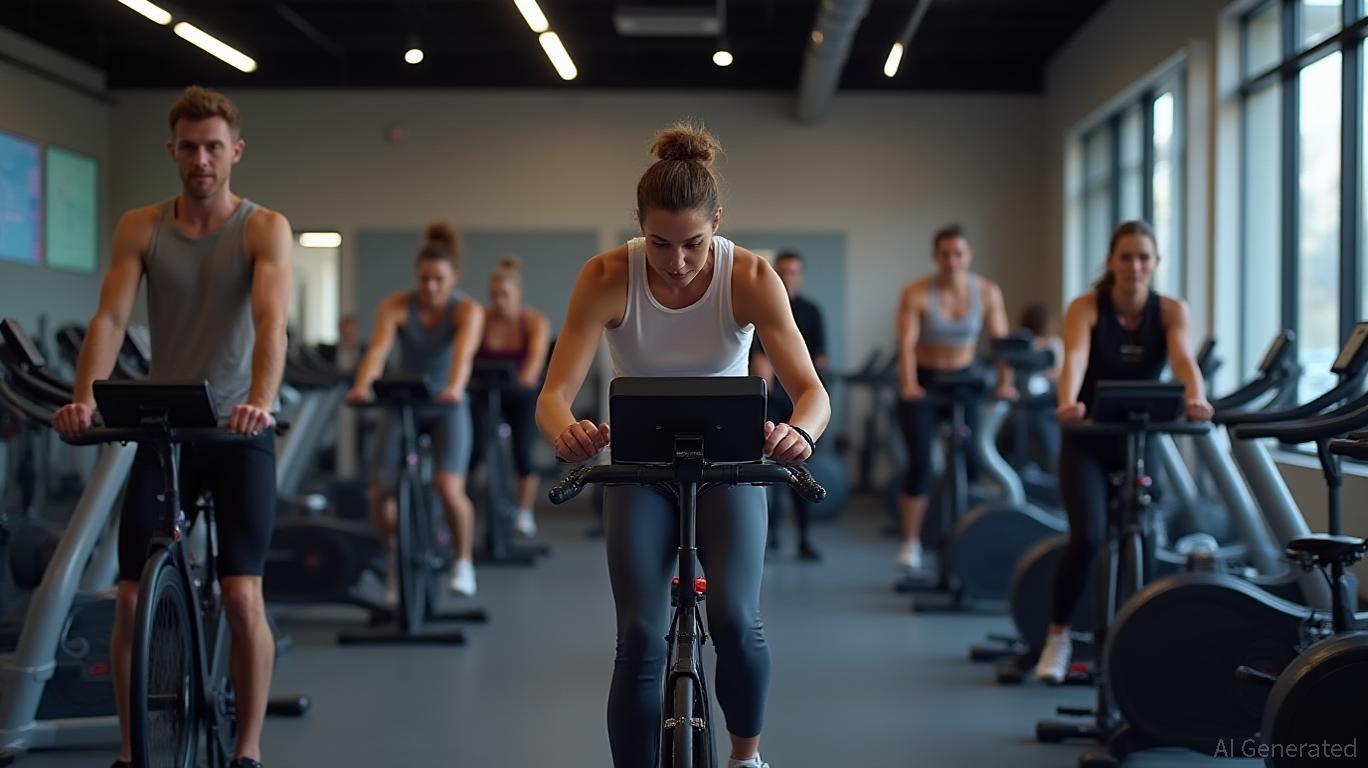
Technology
Top 12 Companies Shaping the Future to 2030
The report “Sports Technology – Company Evaluation Report, 2025” by ResearchAndMarkets.com identifies the top 12 sports technology companies shaping the market to 2030. The key drivers of market growth include enhancing fan engagement, data-driven decision-making, team performance, esports technology, and IoT technologies. However, high initial costs and budget limitations are restraints. Opportunities are emerging with […]

The report “Sports Technology – Company Evaluation Report, 2025” by ResearchAndMarkets.com identifies the top 12 sports technology companies shaping the market to 2030. The key drivers of market growth include enhancing fan engagement, data-driven decision-making, team performance, esports technology, and IoT technologies. However, high initial costs and budget limitations are restraints. Opportunities are emerging with AI, ML, AR, VR, and real-time analytics integration. The report also highlights key players such as Apple, Samsung, Alphabet, and Cisco Systems.
The report “Sports Technology – Company Evaluation Report, 2025” by ResearchAndMarkets.com offers a comprehensive overview of the top 12 sports technology companies that are poised to shape the market landscape by 2030. The report highlights key drivers of market growth, including enhancing fan engagement, data-driven decision-making, team performance, esports technology, and IoT technologies. However, it also notes significant restraints such as high initial costs and budget limitations. The report underscores the potential of emerging technologies like AI, ML, AR, VR, and real-time analytics to drive market growth.
Among the top players identified in the report are Apple, Samsung, Alphabet, and Cisco Systems. These companies are at the forefront of innovation in sports technology, leveraging advanced technologies to revolutionize various aspects of sports, from performance analysis to fan engagement.
Apple Inc., with its Apple Watch Series 10, exemplifies the integration of cutting-edge technology in sports. The smartwatch offers enhanced health management and performance tracking features, making it a popular choice among athletes and sports enthusiasts [1].
Samsung, with its Galaxy Watch Ultra and Watch 7, has also made significant strides in the sports technology market. These smartwatches incorporate AI capabilities and advanced technologies, providing users with improved health management and overall wellness [1].
Alphabet Inc., through its various subsidiaries, is actively involved in developing AI-based solutions for sports analytics and performance enhancement. The company’s Google Cloud platform is used to process and analyze vast amounts of sports data, providing actionable insights for teams and coaches [1].
Cisco Systems, Inc. is another key player in the sports technology market. The company’s networking solutions and IoT technologies are used to enhance stadium operations and fan engagement. Cisco’s solutions help in real-time data processing, improving the overall sports experience for fans [1].
The report also notes that the sports technology market is expected to reach USD 68.70 billion by 2030, growing at a CAGR of 14.9% from 2025 to 2030. This growth is driven by the increasing adoption of AI, IoT, and big data across various segments of the sports industry, including performance analysis, fan interaction, and sports management [1].
In conclusion, the sports technology market is witnessing significant growth and innovation, driven by the integration of advanced technologies. The top 12 companies identified in the report are well-positioned to capitalize on this growth, offering a range of solutions that enhance performance, fan engagement, and overall sports experience.
References:
[1] https://finance.yahoo.com/news/sports-technology-market-reach-68-110000002.html
Technology
Shopping for school supplies becomes a summer activity as families juggle technology and tariffs | News, Sports, Jobs
Dora Diaz, left, and her daughter Fernanda Diaz, 14, shops for school supplies at a Walmart in Dallas, Texas, on Tuesday. (AP photo) NEW YORK — Feeling nostalgic for the days when going back to school meant picking out fresh notebooks, pencils and colored markers at a local drugstore or stationary shop? The annual retail […]

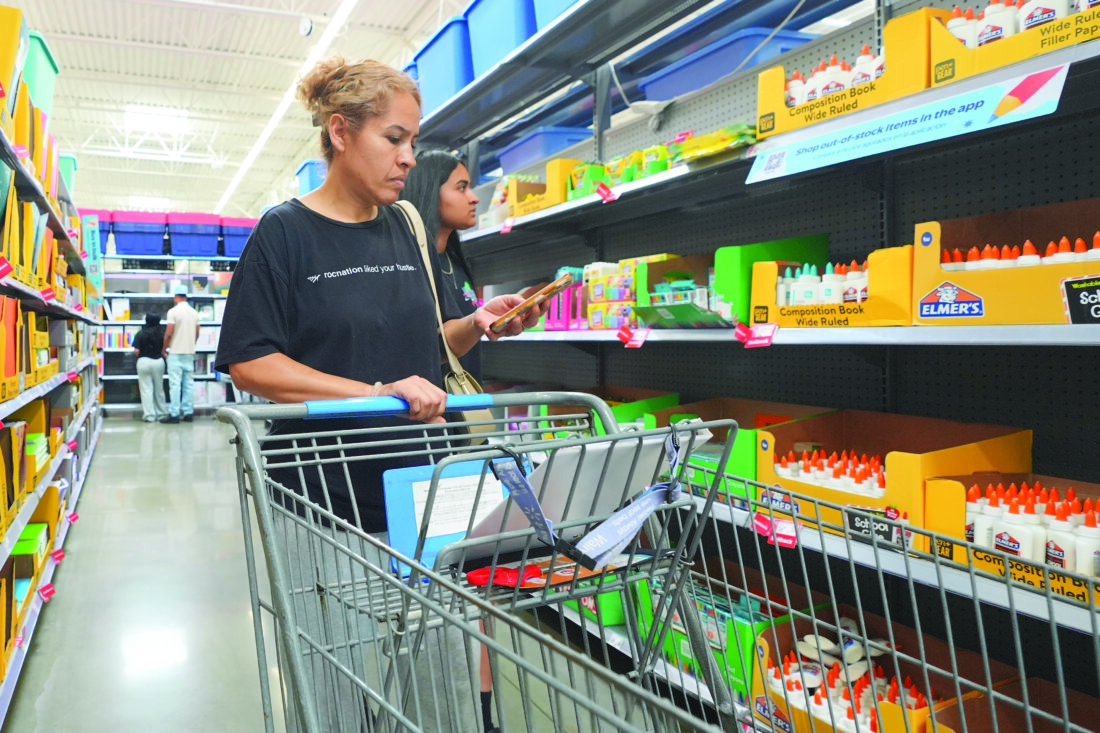
Dora Diaz, left, and her daughter Fernanda Diaz, 14, shops for school supplies at a Walmart in Dallas, Texas, on Tuesday. (AP photo)
NEW YORK — Feeling nostalgic for the days when going back to school meant picking out fresh notebooks, pencils and colored markers at a local drugstore or stationary shop? The annual retail ritual is both easier and more complicated for today’s students.
Chains like Walmart generate online lists of school supplies for customers who type in their zip codes, then choose a school and a grade level. One click and they are ready to check out. Some schools also offer busy parents a one-stop shop by partnering with vendors that sell premade kits with binders, index cards, pens and other needed items.
Yet for all the time-saving options, many families begin their back-to-school shopping months before Labor Day, searching around for the best deals and making purchases tied to summer sales. This year, the possibility of price increases from new U.S. tariffs on imports motivated more shoppers to get a jump start on replacing and refilling school backpacks, according to retail analysts.
Retail and technology consulting company Coresight Research estimates that back-to-school spending from June through August will reach $33.3 billion in the U.S., a 3.3% increase from the same three-month period a year ago. The company predicted families would complete about 60% of their shopping before August to avoid extra costs from tariffs.
“Consumers are of the mindset where they’re being very strategic and conscientious around price fluctuations, so for back to school, it prompts them to shop even earlier,” said Vivek Pandya, lead analyst at Adobe Digital Insights, the research division of software company Adobe Inc.
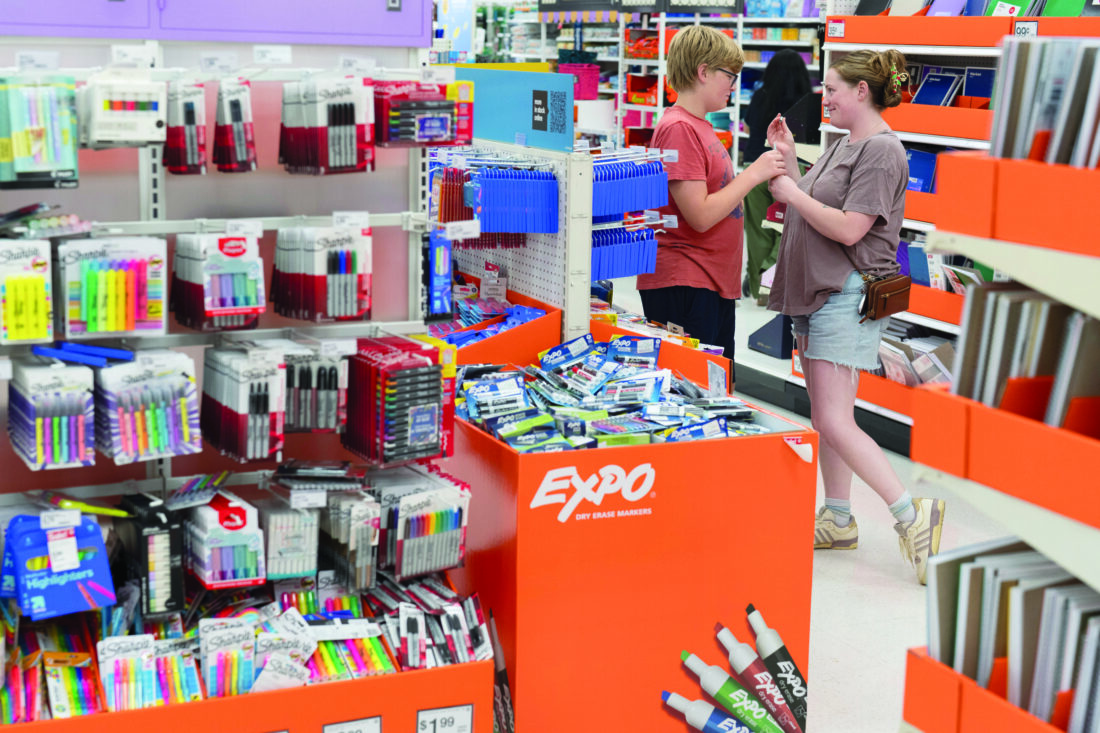
Kylie and Cash Zimmerman shop in the back-to-school supplies section of a Target in Sherwood, Ore., on Friday. (AP photo)
Getting a head start
Miami resident Jacqueline Agudelo, 39, was one of the early birds who started shopping for school supplies in June because she wanted to get ahead of possible price increases from new U.S. tariffs on imported products.
The teacher’s supply list for her 5-year-old son, who started kindergarten earlier this month, mandated specific classroom items in big quantities. Agudelo said her shopping list included 15 boxes of Crayola crayons, Lysol wipes and five boxes of Ticonderoga brand pencils, all sharpened.
Agudelo said she spent $160 after finding plenty of bargains online and in stores, including the crayons at half off, but found the experience stressful.
“I am overwhelmed by the need to stay on top of where the deals are as shopping has become more expensive over the years,” she said.
A lot of the backpacks, lined paper, glue sticks — and Ticonderoga pencils — sold in the U.S. are made in China, whose products were subjected to a 145% tariff in the spring. Under the latest agreement between the countries, Chinese goods are taxed at a 30% rate when they enter the U.S.
Many companies accelerated shipments from China early in the year, stockpiling inventory at pre-tariff prices. Some predicted consumers would encounter higher prices just in time for the back-to-school shopping season. Although government data showed consumer prices rose 2.7% last month from a year earlier, strategic discounting by major retailers may have muted any sticker shock for customers seeking school supplies.
Backpacks and lunchboxes, for example, had discounts as deep as 12.1% during Amazon’s Prime Day sales and competing online sales at Target and Walmart in early July, Adobe Insights said.
Throughout the summer, some of the biggest chains have are advertising selective price freezes to hold onto customers.
Walmart is advertising a 14-item school supplies deal that costs $16, the lowest price in six years, company spokesperson Leigh Stidham said. Target said in June that it would maintain its 2024 prices on 20 key back-to-school items that together cost less than $20.
An analysis consumer data provider Numerator prepared for The Associated Press showed the retail cost of 48 products a family with two school age children might need — two lunchboxes, two scientific calculators, a pair of boy’s shoes — averaged $272 in July, or $3 less than the same month last year.
Digital natives in the classroom
Numerator, which tracks U.S. retail prices through sales receipts, online account activity and other information from 200,000 shoppers, reported last year that households were buying fewer notebooks, book covers, writing instruments and other familiar staples as students did more of their work on computers.
The transition does not mean students no longer have to stock up on plastic folders, highlighters and erasers, or that parents are spending less to equip their children for class. Accounting and consulting firm Deloitte estimates that traditional school supplies will account for more than $7 billion of the $31 billion it expects U.S. parents to put toward back-to-school shopping.
Shopping habits also are evolving. TeacherLists, an online platform where individual schools and teachers can upload their recommended supply lists and parents can search for them, was launched in 2012 to reduce the need for paper lists. It now has more than 2 million lists from 70,000 schools.
Users have the option of clicking on an icon that populates an online shopping cart at participating retail chains. Some retailers also license the data for use on their websites and in their stores, said Dyanne Griffin, the architect and vice president of TeacherLists.
The typical number of items teacher request has remained fairly steady at around 17 since the end of the coronavirus pandemic, Griffin said. “The new items that had come on the list, you know, in the last four or five years are more the tech side. Everybody needs headphones or earbuds, that type of thing, maybe a mouse,” she said.
She’s also noticed a lot of schools requiring clear backpacks and pencil pouches so the gear can’t be used to stow guns.
Enter artificial intelligence
For consumers who like to research their options before they buy, technology and retail companies have introduced generative AI tools to help them find and compare products. Rufus, the AI-powered shopping assistant that Amazon launched last year, is now joined by Sparky, an app-only feature that Walmart shoppers can use to get age-specific product recommendations and other information in response to their questions.
Just over a quarter of U.S. adults say they use AI for shopping, which is considerably lower than the number who say they use AI for tasks such as searching for information or brainstorming, according to an Associated Press-NORC Center for Public Affairs Research poll in July.
Some traditions remain
- Dora Diaz, left, and her daughter Fernanda Diaz, 14, shops for school supplies at a Walmart in Dallas, Texas, on Tuesday. (AP photo)
- Kylie and Cash Zimmerman shop in the back-to-school supplies section of a Target in Sherwood, Ore., on Friday. (AP photo)
Before the pandemic turned a lot more people into online shoppers, schools and local Parent Teacher Associations embraced the idea of making back-to-school shopping easier by ordering ready-made bundles of teacher-recommended supplies. An extra fee on the price helped raise money for the school.
Market data from Edukit, a supplier of school supply kits owned by TeachersList parent company School Family Media, shows that about 40% of parents end up buying the boxes, meaning the other 60% need to shop on their own, Griffin said. She noted that parents typically must commit no later than June to secure a bundle, which focus on essentials like notebooks and crayons.
Agudelo said her son’s school offered a box for $190 that focused on basics like crayons and notebooks but didn’t include a backpack. She decided to pass and shop around for the best prices. She also liked bringing her son along for the shopping trips.
“There’s that sense of getting him mentally prepared for the school year,” Agudelo said. “The box takes away from that.”
Technology
Dublin-based startup secures €650k in pre-seed funding to accelerate the roll-out of it sports wearable
Sports Impact Technologies, an Irish startup which has developed a compact, behind-the-ear sports wearable that detects head impacts in real-time to enhance player safety and performance by eliminating undetected concussions, today announced that it has secured €650,000 in pre-seed funding. The young company was founded in 2022 by Eóin Tuohy, is headquartered at NovaUCD in […]

Sports Impact Technologies, an Irish startup which has developed a compact, behind-the-ear sports wearable that detects head impacts in real-time to enhance player safety and performance by eliminating undetected concussions, today announced that it has secured €650,000 in pre-seed funding.
The young company was founded in 2022 by Eóin Tuohy, is headquartered at NovaUCD in Dublin. This pre-seed investment round, led by private investors with the support of Enterprise Ireland High-Potential Startup (HPSU) funding, will be used by Sports Impact Technologies to accelerate the roll-out of the company’s beta product.
The wearable sensor, which is sport and player agnostic and sits comfortably and discreetly behind the ear, monitors head impacts during a game by recording head accelerations. Data and alerts are transmitted in real-time via an app to coaches, medical staff, or safety officials who can then make an informed decision to take a player off the pitch to be assessed for concussion, reducing the risk of further injury and ensuring player safety on the field.
Eóin Tuohy, CEO and founder, Sports Impact Technologies said: “It is estimated that between 5% and 10% of players experience a concussion in any given sports season, with 5 in 10 concussions going unreported or undetected leading to players experiencing long-term health implications. Using our smart sensor technology to monitor head impacts in real-time, our goal is to make unrecognised concussions a thing of the past protecting athletes, optimising their performance, and enabling participation.”
He added, “We’re thrilled to have closed this funding round with the backing of both private investors and Enterprise Ireland. The investment will support the final stages of product development and help us bring our beta wearable to market. We are launching beta-testing programmes with pilot customers in sports ranging from American football to rugby to soccer, hockey and GAA football this September, which will provide valuable real-world data and position us for a full product launch early next year.”
Sports Impact Technologies previously completed the Enterprise Ireland funded New Frontiers Programme at TU Dublin and secured €100k in Enterprise Ireland PSSF funding. The company, also an ESA BIC client company, was named the winner of the ‘Best New Start’ Award in the Connacht and Leinster regional final of 2024 InterTradeIreland Seedcorn Investor Readiness Competition.
Technology
Most US stocks fall after a disappointing inflation update
By STAN CHOE, AP Business Writer NEW YORK (AP) — Most stocks fell on Wall Street Thursday after a disappointing report said inflation was worse last month at the U.S. wholesale level than economists expected. But gains for Amazon and some other influential Big Tech companies helped mask the losses. Seven out of every 10 stocks within […]
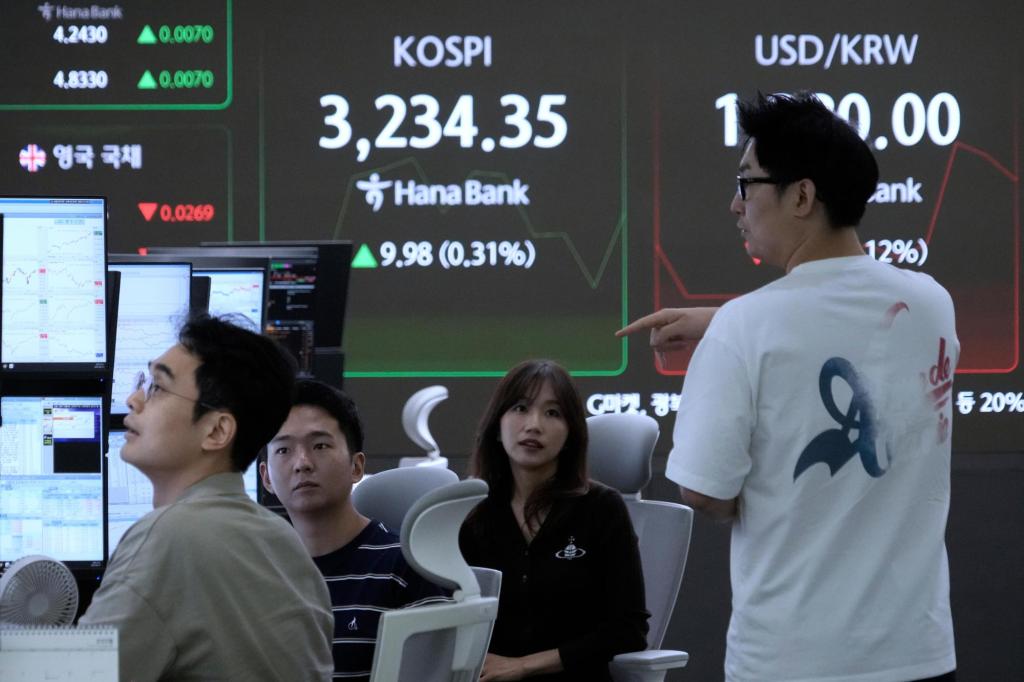
By STAN CHOE, AP Business Writer
NEW YORK (AP) — Most stocks fell on Wall Street Thursday after a disappointing report said inflation was worse last month at the U.S. wholesale level than economists expected. But gains for Amazon and some other influential Big Tech companies helped mask the losses.
Seven out of every 10 stocks within the S&P 500 fell, though the index edged up by less than 0.1% to set another all-time high. The Dow Jones Industrial Average dipped 11 points, or less than 0.1%, and the Nasdaq composite dipped by less than 0.1% from its record set the day before.
The inflation report said that prices jumped 3.3% last month at the U.S. wholesale level from a year earlier. That was well above the 2.5% rate that economists had forecast, and it could hint at higher inflation ahead for U.S. shoppers as it makes its way through the system.
The data forced traders to second guess their widespread consensus that the Federal Reserve will cut interest rates at its next meeting in September. Lower rates can boost investment prices and the economy by making it cheaper for U.S. households and businesses to borrow to buy houses, cars or equipment, but they also risk worsening inflation.
“This doesn’t slam the door on a September rate cut,” but it may raise some doubt, according to Chris Larkin, managing director, trading and investing, at E-Trade from Morgan Stanley.
Traders now see a 7.4% chance that the Fed may hold rates steady in September, according to data from CME Group. A day earlier, they were betting on a 100% certainty that the Fed would cut its main rate for the first time this year.
Higher interest rates drag on all kinds of companies by keeping the cost to borrow high. They can hurt smaller companies in particular because they often need to borrow to grow. The Russell 2000 index of smaller U.S. stocks tumbled a market-leading 1.2%.
Thursday’s disappointing data followed an encouraging update earlier in the week on prices at the consumer level. A separate report on Thursday, meanwhile, said fewer U.S. workers applied for unemployment benefits last week. That’s a good sign for workers, indicating that layoffs remain relatively low at a time when job openings have become more difficult to find.
But a solid job market could also give the Fed less reason to cut interest rates in the short term.
The data helped send Treasury yields higher in the bond market. The yield on the 10-year Treasury climbed to 4.28% from 4.20% just before the data reports’ release and from 4.24% late Wednesday.
On Wall Street, Tapestry tumbled after the company behind the Coach and Kate Spade New York brands showed it’s feeling the pressure of tariffs.
It detailed how much profit it could lose in its upcoming fiscal year because of tariffs and duties, and its forecast for profit fell short of analysts’ expectations even though its forecast for revenue came in above. Its stock fell 15.7%, despite it also reporting a stronger profit for the latest quarter than analysts expected.
Deere fell 6.8% even though the machinery maker likewise delivered a better profit than expected. There, too, the focus was on where profits are heading. It cut the top end of its forecasted range for profit this fiscal year and said its customers “remain cautious amid ongoing uncertainty.”
On the winning side of Wall Street was Fossil Group, which jumped 29.8% after the seller of watches and other accessories reported better profit than expected. It also announced a plan to strengthen its finances, while trimming its forecast for how much it expects worldwide net sales to fall this year.
Big Tech stocks also helped mask Wall Street’s losses. Amazon rose 2.9% to add to its gains from the prior day when it announced same-day delivery of fresh groceries in more than 1,000 cities and towns.
Because Amazon is so huge, with a market value of $2.45 trillion, the movements for its stock carry much more weight on the S&P 500 than the typical company’s.
All told, the S&P 500 rose 1.96 to 6,468.54 points. The Dow Jones Industrial Average edged down 11.01 to 44,911.26, and the Nasdaq composite dipped 2.47 to 21.710.67.
In stock markets abroad, indexes were mixed across Asia and Europe ahead of a key meeting between U.S. President Donald Trump and Russian President Vladimir Putin on Friday.
AP Writers Teresa Cerojano and Matt Ott contributed.
Originally Published:
-

 Technology3 weeks ago
Technology3 weeks agoAlly Runs New Game Plan in WNBA All-Star Rookie Debut
-

 Health2 weeks ago
Health2 weeks agoThe Women Driving A New Era In U.S. Ski & Snowboard
-

 NIL2 weeks ago
NIL2 weeks agoESPN Announces 'dont wait run fast' by mgk as New College Football Anthem for 2025
-

 College Sports3 weeks ago
College Sports3 weeks agoCity rows to sporting destination goal on boats of new complexes & old strengths
-
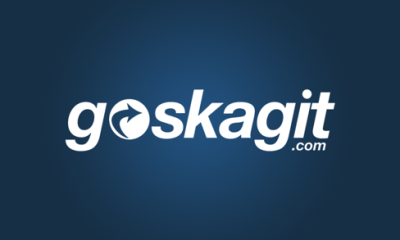
 Sports3 weeks ago
Sports3 weeks agoNtekpere honored as Second Team Academic All-American | APG State News
-

 Rec Sports1 week ago
Rec Sports1 week agoSwimming & Diving Comments on the Rules – 2025-26
-

 Technology1 week ago
Technology1 week agoAmid Sports Chaos, ‘Known’ Data and Outcomes Help Agency Win
-

 College Sports2 weeks ago
College Sports2 weeks agoRep. Pugh: The Red Sand Project brings awareness to ‘very serious issue’
-

 Rec Sports1 week ago
Rec Sports1 week agoSternberg named new youth center director | News, Sports, Jobs
-

 Fashion3 weeks ago
Fashion3 weeks agoWhere to watch Chile vs. Paraguay today


